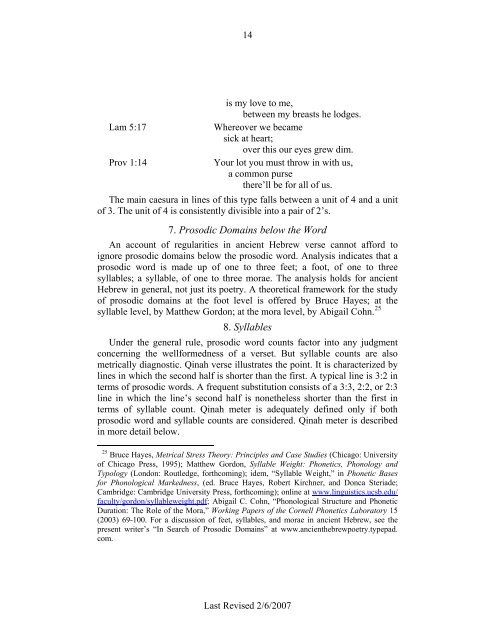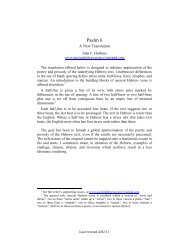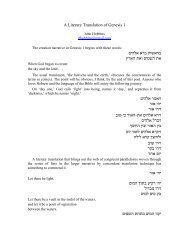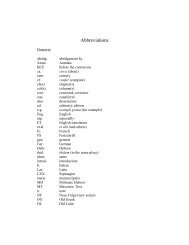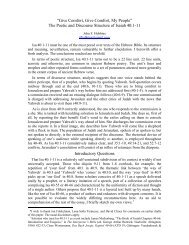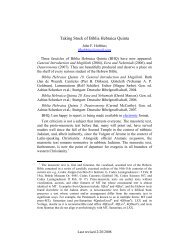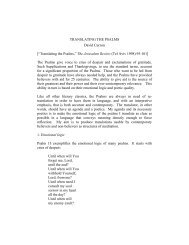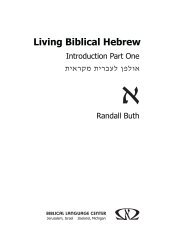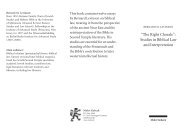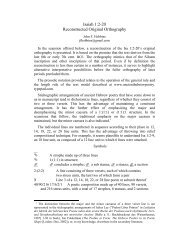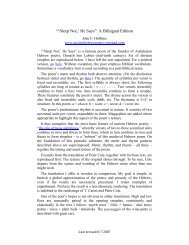14Lam 5:17Prov 1:14is my love to me,between my breasts he lodges.Whereover we becamesick at heart;over this our eyes grew dim.Your lot you must throw in with us,a common pursethere’ll be for all of us.The main caesura in lines of this type falls between a unit of 4 and a unitof 3. The unit of 4 is consistently divisible into a pair of 2’s.7. Prosodic Domains below the WordAn account of regularities in ancient <strong>Hebrew</strong> verse cannot afford toignore prosodic domains below the prosodic word. Analysis indicates that aprosodic word is made up of one to three feet; a foot, of one to threesyllables; a syllable, of one to three morae. The analysis holds for ancient<strong>Hebrew</strong> in general, not just its poetry. A theoretical framework for the studyof prosodic domains at the foot level is offered by Bruce Hayes; at thesyllable level, by Matthew Gordon; at the mora level, by Abigail Cohn. 258. SyllablesUnder the general rule, prosodic word counts factor into any judgmentconcerning the wellformedness of a verset. But syllable counts are alsometrically diagnostic. Qinah verse illustrates the point. It is characterized bylines in which the second half is shorter than the first. A typical line is 3:2 interms of prosodic words. A frequent substitution consists of a 3:3, 2:2, or 2:3line in which the line’s second half is nonetheless shorter than the first interms of syllable count. Qinah meter is adequately defined only if bothprosodic word and syllable counts are considered. Qinah meter is describedin more detail below.25 Bruce Hayes, Metrical Stress Theory: Principles and Case Studies (Chicago: Universityof Chicago Press, 1995); Matthew Gordon, Syllable Weight: Phonetics, Phonology andTypology (London: Routledge, forthcoming); idem, “Syllable Weight,” in Phonetic Basesfor Phonological Markedness, (ed. Bruce Hayes, Robert Kirchner, and Donca Steriade;Cambridge: Cambridge University Press, forthcoming); online at www.linguistics.ucsb.edu/faculty/gordon/syllableweight.pdf; Abigail C. Cohn, “Phonological Structure and PhoneticDuration: The Role of the Mora,” Working Papers of the Cornell Phonetics Laboratory 15(2003) 69-100. For a discussion of feet, syllables, and morae in ancient <strong>Hebrew</strong>, see thepresent writer’s “In Search of Prosodic Domains” at www.ancienthebrewpoetry.typepad.com.Last Revised 2/6/2007
15If a system of twos and threes is evident at the word level and above, at amore elementary level, that of syllables, the rhythm is freer, though notwithout constraints: one to six syllables is the syllable count up to andincluding the syllable receiving the dominant stress in a prosodic word. Thismeasure of the maximum length of a prosodic word is important in theestablishment of a threshold for the decliticization of proclitics. 26If one to six syllables make up a prosodic word, the number of syllablesin a verset will hypothetically fall in a range that goes from two to eighteenin a system of two and threes (in a system of two, threes, and fours, a two totwenty-four range would obtain). The range is far narrower in fact. It hasbeen customary to think in terms of averages. Analysis suggests that aprosodic word consists on average of between two and three syllables. Onaverage, therefore, there will be between four to nine syllables to a verset. Astatistical convergence in the range of four to nine syllables per verset iscompatible with the findings of Freedman, Fokkelman, and Bartelt, to citethree major practitioners of the syllable counting method. 27 Nevertheless,despite claims made for averages, it seems unlikely that this convergence ismore than an epiphenomenon of other regularities in <strong>Hebrew</strong> versestructure. 2826 Harm van Grol (De versbouw in het klassieke hebreeuws: Fundamentele verkenningen,Deel 1: Metriek [diss., Catholic Theological University of Amsterdam: Amsterdam, 1986]148-51, 240) also sets an upper limit of six syllables per stress unit. Stress units of more thanfive syllables up to and including the maximally stressed syllable are atypical. For areconstruction of rules governing the formation of prosodic words in ancient <strong>Hebrew</strong>, seethe present writer’s “Stress in <strong>Ancient</strong> <strong>Hebrew</strong>: A Tentative Reconstruction” atwww.ancienthebrewpoetry.typepad.com.27 David Noel Freedman, “Acrostics and Metrics in <strong>Hebrew</strong> <strong>Poetry</strong>,” HTR 65 (1972) 367-92; 392 (repr. in Pottery, <strong>Poetry</strong>, and Prophecy: Collected Essays on <strong>Hebrew</strong> <strong>Poetry</strong>(Winona Lake, Eisenbrauns, 1980) 51-76; 76 [six and a half to nine syllables per verset onaverage]; Jan Fokkelman, Reading Biblical <strong>Poetry</strong>, 47-8 [seven to nine syllables per verseton average, with 8 indicated as “the central norm figure of prosody”]; Andrew H. Bartelt,The Book around Immanuel: Style and Structure in Isaiah 2-12 (BJSUCSD 4; Winona Lake:Eisenbrauns, 1996) 247 [8 syllable norm for a verset].28 For syllable count averages to be more than a byproduct of overall regularity, one has toassume that poets reworked their poems until calculations proved a normative syllable countaverage had been achieved. This is not a likely scenario. Nevertheless, to judge fromEusebius of Caesarea, according to whom “it is said” that Deut 32 and Ps 119 “arecomposed in what the Greeks call heroic meter,” that is, “hexameters consisting of sixteensyllables” (Praep. ev. XI, 5), the practice of counting the syllables of ancient <strong>Hebrew</strong> verseis at least as old as the comparative study of Greek and <strong>Hebrew</strong> poetry.Last Revised 2/6/2007


